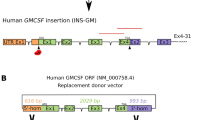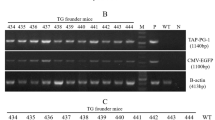Abstract
Infection of the mammary gland, in addition to causing animal distress, is a major economic burden of the dairy industry. Staphylococcus aureus is the major contagious mastitis pathogen, accounting for approximately 15–30% of infections, and has proved difficult to control using standard management practices. As a first step toward enhancing mastitis resistance of dairy animals, we report the generation of transgenic mice that secrete a potent anti-staphylococcal protein into milk. The protein, lysostaphin, is a peptidoglycan hydrolase normally produced by Staphylococcus simulans. When the native form is secreted by transfected eukaryotic cells it becomes glycosylated and inactive. However, removal of two glycosylation motifs through engineering asparagine to glutamine codon substitutions enables secretion of Gln125,232-lysostaphin, a bioactive variant. Three lines of transgenic mice, in which the 5′-flanking region of the ovine β-lactoglobulin gene directed the secretion of Gln125,232-lysostaphin into milk, exhibit substantial resistance to an intramammary challenge of 104 colony-forming units (c.f.u.) of S. aureus, with the highest expressing line being completely resistant. Milk protein content and profiles of transgenic and nontransgenic mice are similar. These results clearly demonstrate the potential of genetic engineering to combat the most prevalent disease of dairy cattle.
This is a preview of subscription content, access via your institution
Access options
Subscribe to this journal
Receive 12 print issues and online access
$209.00 per year
only $17.42 per issue
Buy this article
- Purchase on Springer Link
- Instant access to full article PDF
Prices may be subject to local taxes which are calculated during checkout





Similar content being viewed by others
References
Kossaibati, M.A., Hovi, M. & Esslemont, R.J. Incidence of clinical mastitis in dairy herds in England. Vet. Rec. 143, 649–653 (1998).
Myllys, V. et al. Bovine mastitis in Finland in 1988 and 1995—changes in prevalence and antimicrobial resistance. Acta Vet. Scand. 39, 119–126 (1998).
Auldist, M.J., Coats, S., Rogers, G.L. & McDowell, G.H. Changes in the composition of milk from healthy and mastitic dairy cows during the lactation cycle. Aust. J. Exp. Agric. 35, 427–436 (1995).
Auldist, M.J. et al. Effect of somatic cell count and stage of lactation on the quality and storage life of ultra high temperature milk. J. Dairy Res. 63, 377–386 (1996).
Barbano, D.M., Rasmussen, R.R. & Lynch, J.M. Influence of milk somatic cell count and milk age on cheese yield. J. Dairy Sci. 74, 369–388 (1991).
Klei, L. et al. Effects of milk somatic cell count on cottage cheese yield and quality. J. Dairy Sci. 81, 1205–1213 (1998).
Bramley, A.J. & Dodd, F.H. Reviews of the progress of dairy science: mastitis control—progress and prospects. J. Dairy Res. 51, 481–512 (1984).
Sutra, L. & Poutrel, B. Virulence factors involved in the pathogenesis of bovine intramammary infections due to Staphylococcus aureus. J. Med. Microbiol. 40, 79–89 (1994).
Craven, N. & Anderson, J.C. Phagocytosis of Staphylococcus aureus by bovine mammary gland macrophages and intracellular protection from antibiotic action in vitro and in vivo. J. Dairy Res. 51, 513–523 (1984).
Yancey, R.J., Sanchez, M.S. & Ford, C.W. Activity of antibiotics against Staphylococcus aureus within polymorphonuclear neutrophils. Eur. J. Clin. Microbiol. Infect. Dis. 10, 107–113 (1991).
Oldham, E.R. & Daley, M.J. Lysostaphin: use of a recombinant bactericidal enzyme as a mastitis therapeutic. J. Dairy Sci. 74, 4175–4182 (1991).
Watson, D.L. Vaccination against experimental staphylococcal mastitis in dairy heifers. Res. Vet. Sci. 53, 346–353 (1992).
Schindler, C.A. & Schuhardt, V.T. Lysostaphin: a new bacteriolytic agent for the Staphylococcus. Proc. Natl. Acad. Sci. USA 51, 414–421 (1964).
Bramley, A.J. & Foster, R. Effects of lysostaphin on Staphylococcus aureus infections of the mouse mammary gland. Res. Vet. Sci. 49, 120–121 (1990).
Gordon, K. et al. Production of human tissue plasminogen activator in transgenic mouse milk. Bio/technology 5, 1183–1187 (1987).
Wall, R. J. et al. High-level synthesis of a heterologous milk protein in the mammary glands of transgenic swine. Proc. Natl. Acad. Sci. USA 88, 1696–1700 (1991).
Wright, G. et al. High level expression of active human alpha-1-antitrypsin in the milk of transgenic sheep. Bio/Technology 9, 830–834 (1991).
Ebert, K. M. et al. Transgenic production of a variant of human tissue-type plasminogen activator in goat milk: generation of transgenic goats and analysis of expression. Bio/Technology 9, 835–838 (1991).
Krimpenfort, P. et al. Generation of transgenic dairy cattle using `in vitro' embryo production. Bio/Technology 9, 844–847 (1991).
Maga, E.A., Anderson, G.B., Huang, M.C. & Murray, J.D. Expression of human lysozyme mRNA in the mammary gland of transgenic mice. Transgenic Res. 3, 36–42 (1994).
Williamson, C.M., Bramley, A.J. & Lax, A.J. Expression of the lysostaphin gene of Staphylococcus simulans in a eukaryotic system. Appl. Environ. Microbiol. 60, 771–776 (1994).
Maga, E.A., Anderson, G.B. & Murray, J.D. The effect of mammary gland expression of human lysozyme on the properties of milk from transgenic mice. J. Dairy Sci. 78, 2645–2652 (1995).
Verdi, R.J., Barbano, D.M., Dellavalle, M.E. & Senyk, G.F. Variability in true protein, casein, nonprotein nitrogen, and proteolysis in high and low somatic cell milks. J. Dairy Sci. 70, 230–242 (1987).
Whitelaw, C.B. et al. Targeting expression to the mammary gland: intronic sequences can enhance the efficiency of gene expression in transgenic mice. Transgenic Res. 1, 3–13 (1991).
Wall, R.J. & Seidel, G. Jr. Transgenic farm animals—a critical analysis. Theriogenology 38, 337–357 (1992).
Marais, R. et al. A cell surface tethered enzyme improves efficiency in gene-directed enzyme producing therapy. Nat. Biotechnol. 15, 1373–1377 (1997).
Reiter, B. Review of the progress of dairy science: antimicrobial systems in milk. J. Dairy Res. 45, 131–147 (1978).
Takahashi, N. et al. Nonspecific antibacterial factors in milk from cows immunized with human oral bacterial pathogens. J. Dairy Sci. 75, 1810–1820 (1992).
Platenburg, G.J. et al. Expression of human lactoferrin in milk of transgenic mice. Transgenic Res. 3, 99–108 (1994).
Yarus, S., Rosen, J.M., Cole, A.M. & Diamond, G. Production of active bovine tracheal antimicrobial peptide in milk of transgenic mice. Proc. Natl. Acad. Sci. USA 93, 14118–14121 (1996).
Maga, E.A., Anderson, G.B., Cullor, J.S., Smith, W. & Murray, J.D. Antimicrobial properties of human lysozyme transgenic mouse milk. J. Food Prot. 61, 52–56 (1998).
Harmon, R.J., Schanbacher, F.L., Ferguson, L.C. & Smith, K.L. Concentration of lactoferrin in milk of normal lactating cows and changes occurring during mastitis. Am. J. Vet. Res. 36, 1001–1007 (1975).
Drews, R. et al. Proteolytic maturation of protein C upon engineering the mouse mammary gland to express furin. Proc. Natl. Acad. Sci. USA 92, 10462–10466 (1995).
Chandler, R.L. Experimental bacterial mastitis in the mouse. J. Med. Microbiol. 3, 273–282 (1970).
Acknowledgements
We thank Juli Foster, Leah Schulman, Barbara Hughes, and Francis Kinghorn for excellent technical assistance. The work was funded in part by grants from The Northeast Dairy Foods Research Center, the Vermont Dairy Promotion Council, and the New England Dairy Promotion Board.
Author information
Authors and Affiliations
Corresponding author
Rights and permissions
About this article
Cite this article
Kerr, D., Plaut, K., Bramley, A. et al. Lysostaphin expression in mammary glands confers protection against staphylococcal infection in transgenic mice. Nat Biotechnol 19, 66–70 (2001). https://doi.org/10.1038/83540
Received:
Accepted:
Issue Date:
DOI: https://doi.org/10.1038/83540
This article is cited by
-
Self-cleaved expression of recombinant lysostaphin from its cellulose binding domain fusion
Applied Microbiology and Biotechnology (2022)
-
Antimicrobial peptides: features, applications and the potential use against covid-19
Molecular Biology Reports (2022)
-
Functional evaluation of a monotreme-specific antimicrobial protein, EchAMP, against experimentally induced mastitis in transgenic mice
Transgenic Research (2019)
-
Genetic engineering of mammals
Cell and Tissue Research (2016)
-
Triple-acting Lytic Enzyme Treatment of Drug-Resistant and Intracellular Staphylococcus aureus
Scientific Reports (2016)



